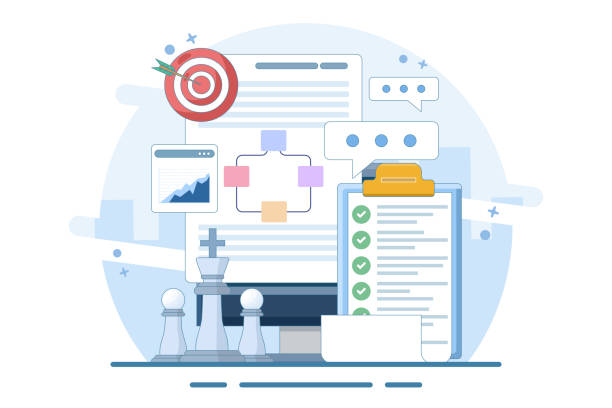Introduction to the Importance of Secure Website Design

In today’s digital world, where a huge portion of our interactions and financial transactions occur daily through websites, the importance of secure website design has become more evident than ever.
It is no longer possible to launch a website without considering its security dimensions, as the risks associated with cyber attacks and data breaches are very high, both financially and reputationally.
This article, as a comprehensive and #educational guide, explores various aspects of #secure_website_design, from basic concepts to advanced techniques.
Our goal is to provide a #specialized and #explanatory perspective on how to create a secure web environment that can protect user and business information against ever-increasing threats.
We will help you achieve a secure and reliable website by adhering to the necessary standards.
Have you ever considered the immense consequences a small data leak can have for you or your organization? This issue not only leads to financial losses but also severely damages customer reputation and trust.
Therefore, a preventative approach to web security and investment in secure website design is not a luxury choice, but a vital necessity.
This is the first step in protecting your digital assets.
The importance of user trust in online platforms cannot be overstated; without it, no online business can succeed in the long run.
In recent years, we have witnessed a significant increase in the number and complexity of cyber attacks.
From ransomware attacks that hold data hostage to massive data breaches affecting millions of users, alarming news on this front is published daily.
This trend further highlights the necessity of a comprehensive and all-encompassing approach to website security.
Simply installing a firewall or an SSL certificate is not enough; secure website design must be woven into the fabric of the project from the idea stage through implementation and maintenance.
This means considering security throughout the Software Development Life Cycle (SDLC), i.e., addressing security concerns from the very beginning in all stages of planning, design, development, testing, and deployment.
This analytical approach to security not only reduces the costs resulting from attacks but also strengthens your brand reputation and credibility.
In other words, security is a competitive advantage.
In upcoming chapters, we will detail the key elements of secure website design and practical solutions to achieve it.
Are you tired of your e-commerce site having visitors but no sales? Rasaweb solves your main problem with professional e-commerce website design!
✅ Significant sales increase with targeted design
✅ Flawless user experience for your customers
⚡ Get a free consultation!
Common Web Security Threats and How to Identify Them

Knowing the enemy is the first step in defeating it.
In the realm of website security, this enemy is the cyber threats that are constantly evolving and becoming more sophisticated.
A thorough analysis of these threats is essential for secure website design.
Among the most common and destructive of these attacks is SQL Injection, which allows an attacker to access and modify database data.
Cross-Site Scripting (XSS) is another type where an attacker injects malicious code into web pages to steal user information.
DDoS (Distributed Denial of Service) attacks also take websites offline by sending a massive volume of traffic to the server.
Phishing, Brute Force attacks, and Malware are also serious risks.
In a thought-provoking approach, one should ask: “Do you regularly scan your website to identify these vulnerabilities?” Many of these attacks occur through known weaknesses that can be prevented with regular updates and the use of security tools.
Cybersecurity teams use tools such as vulnerability scanners and Penetration Testing to discover these weaknesses before attackers do.
These tools, by simulating attacks, provide precise reports of weaknesses, which are crucial for strengthening website security.
Staff training and awareness regarding common threats are also vital in this area, as many intrusions occur due to human error or non-adherence to security protocols by internal users.
The ultimate goal in secure website design is to build a strong fortress against these constant threats.
By deeply understanding these attack mechanisms, we can implement more effective defense strategies and prevent irreparable damages.
Staying up-to-date with the latest security news and reports helps us to always be one step ahead of attackers.
Basic Principles of Secure Website Design and Secure Coding

The foundation of website security begins in the very initial stages of design and coding.
A secure website design requires adherence to secure coding principles and best development practices.
Among the most important of these principles is Input Validation.
Any data received from the user must be carefully reviewed and filtered to prevent the injection of malicious code or unauthorized data.
Using Prepared Statements in database interactions is an effective way to combat SQL Injection by separating query code from input data, preventing the execution of malicious code.
Furthermore, applying the Principle of Least Privilege to users and systems prevents the spread of damage in case of a breach.
This means that each user or module only has the minimum necessary access to perform its function.
Proper Error Handling is also very important; displaying generic error messages instead of technical details can prevent the disclosure of sensitive system or database information.
Regular updates of libraries and frameworks are also vital, as many vulnerabilities exist in older versions and are fixed with security updates.
This specialized guidance is for developers to achieve a strong security foundation.
Below is a table of key steps in secure coding:
| Security Principle | Description | Example/Application |
|---|---|---|
| Input Validation | Ensuring the correctness and security of user-received data before processing. | Checking email format, password length, preventing injected scripts (XSS). |
| Using Prepared Statements | Preventing SQL Injection attacks by separating code and data in database queries. | Using PDO in PHP or JDBC PreparedStatement in Java for query execution. |
| Proper Error Handling | Displaying generic error messages to users and logging detailed errors in secure server logs. | Not displaying technical database details or file paths in programming errors. |
| Least Privilege | Granting the minimum necessary access rights to users, processes, and modules. | Not granting root access to all users or database services. |
Additionally, using Content Security Policy (CSP) can help protect against XSS.
This policy tells the browser which resources (scripts, styles, etc.) are allowed to load on the page and prevents the execution of unauthorized code.
Secure Session Management is also of high importance; use strong and random session tokens and expire them at the appropriate time.
Finally, regular security tests and code reviews by independent teams throughout the development process are an integral part of secure website design to ensure no new vulnerabilities have been introduced into the code.
Selecting and Configuring a Secure Server and Hosting

The security of a website is not limited to its coding alone; the server and hosting infrastructure also plays a vital role in secure website design.
Choosing a reputable and well-known hosting provider that adheres to high security standards is the first step.
These providers typically have dedicated security teams, attack-resistant infrastructures, and security certifications such as ISO 27001.
After selecting hosting, secure server configuration is of utmost importance.
This includes regular updates of the operating system and server software (such as web server, database, and programming languages), disabling unnecessary services to reduce the attack surface, and precise Firewall configurations to control inbound and outbound traffic.
Using a WAF (Web Application Firewall) provides an additional layer of security against common website attacks such as SQL Injection and XSS.
This tool acts as a smart filter, blocking malicious traffic before it reaches the website.
For larger and high-traffic websites, using a CDN (Content Delivery Network) not only increases loading speed but also significantly contributes to website security by distributing traffic and protecting against DDoS attacks.
These are specialized and practical guidelines for securing a secure infrastructure.
Did you know that many intrusions occur through default and insecure server configurations? This is an alarming news fact that requires serious attention.
Regular monitoring of server logs to identify suspicious activities and using secure protocols like SFTP instead of FTP for file transfers are other essential measures for a secure website design.
Also, implementing strong policies for administrative passwords and enabling two-factor authentication (2FA) for host and server management panels significantly strengthens defensive layers.
Server security is the backbone of your overall website security, and without it, no secure and stable website can be expected.
Are you frustrated with your e-commerce site’s low conversion rate? Rasaweb transforms your e-commerce site into a powerful tool for attracting and converting customers!
✅ Significantly increase visitor-to-buyer conversion rates
✅ Exceptional user experience to boost customer satisfaction and loyalty⚡ Get a free consultation from Rasaweb now!
Database Management and Protection of Sensitive Information

The database is the beating heart of every website, containing the most valuable information, including user data, transaction records, and site content.
Protecting this data is one of the most challenging and critical aspects of database security in secure website design.
The first step is to use strong encryption for sensitive data, especially user passwords.
Never store passwords in plain text; instead, use strong and up-to-date hashing functions (like bcrypt or Argon2) with appropriate ‘salt’ so that user passwords remain unidentifiable even in the event of a database breach.
This is a specialized explanation essential for preventing brute-force and dictionary attacks.
Restricting database access is also of great importance; only users and applications with an imperative need for access should be authorized to connect, and with the minimum necessary access.
For instance, a user whose sole task is to read information should not have editing or deletion privileges, and network connections should only originate from authorized IP addresses.
Regular monitoring of database logs to identify suspicious activities such as failed login attempts or unusual queries is another essential measure.
Using Database Management Systems (DBMS) with advanced built-in security features and regularly updating them eliminates known security holes and applies the latest security patches.
Have you ever considered how disastrous a database breach can be? This thought-provoking yet alarming content emphasizes the importance of investing in database security.
Regular and encrypted backups of the database are a vital strategy for information recovery in case of a disaster.
These backups should be stored in a secure location, separate from the main server, preferably in cloud storage with precise access control.
This comprehensive guide helps you ensure the security of your sensitive information and complete a secure website design.
Protecting your database is protecting your business.
The Role of SSL/TLS Certificates in Web Security

One of the most recognized and fundamental components in secure website design is the use of an SSL/TLS certificate and the activation of the HTTPS protocol.
HTTPS (Hypertext Transfer Protocol Secure) is the secure version of HTTP that encrypts the communication between the user’s browser and the website server.
This encryption prevents eavesdropping, data tampering, and identity spoofing during transmission.
When a user connects to an HTTPS website, a green padlock icon or the word “Secure” appears in the browser’s address bar, indicating a secure and trustworthy connection.
This assures users that their submitted information (such as passwords, credit card details, and personal data) is protected during transit and cannot be intercepted by third parties.
From an SEO perspective, Google considers HTTPS as a ranking factor and gives positive points to SSL-enabled websites, so using SSL/TLS is crucial not only for security but also for improving website visibility in search results.
This is an educational explanation about the vital role of this technology.
Did you know that without HTTPS, anyone on the same network (e.g., a public Wi-Fi network) can easily see the information you send or receive? This is a shocking truth that highlights the necessity of transport layer security.
There are various types of SSL/TLS certificates, from Domain Validation (DV) for blogs and personal sites, which only confirms domain ownership, to Extended Validation (EV) for large organizations, which provides the highest level of trust and displays the organization’s identity information in the address bar.
Choosing the right certificate depends on your website’s needs, the type of information processed, and your budget.
In summary, HTTPS is a fundamental requirement in modern secure website design, holding unparalleled importance both technically and in terms of user trust, and should be activated for all websites.
Continuous Monitoring and Improvement of Website Security

Website security is a continuous and dynamic process, not a static goal.
Even after the initial secure website design, it is necessary for the website to be continuously examined for new vulnerabilities and emerging threats.
This includes regular security scans, reviewing server and application logs, and continuous updates of all website components.
Vulnerability scanning tools can help identify known weaknesses in code, server configurations, or third-party dependencies.
These scans can be performed automatically and regularly to quickly identify and address any security weaknesses.
Furthermore, conducting Penetration Testing by cybersecurity specialists is a specialized and effective method for simulating real attacks and discovering more complex vulnerabilities that automated tools cannot detect.
These processes, in an analytical and guiding manner, help you become aware of your website’s security posture and uncover hidden weaknesses.
Updating the core of the Content Management System (CMS), plugins, themes, and any third-party libraries is among the most important tasks that must be done regularly.
Many successful attacks occur due to untimely software updates and the presence of known vulnerabilities in older versions.
Continuous monitoring of network traffic and user behavior to identify suspicious patterns is also vital.
| Activity | Description | Suggested Timeframe |
|---|---|---|
| Automated Vulnerability Scanning | Using automated tools to identify common weaknesses in code and server. | Monthly or after any major code change. |
| Penetration Testing | Simulating real attacks by security specialists to discover complex vulnerabilities. | Annually or after significant structural changes in the system. |
| Software and Patch Updates | Updating CMS core, plugins, themes, libraries, and server operating system. | Immediately upon release of security updates and bug fixes. |
| Log Review and Security Monitoring | Monitoring server, web server, and application logs to identify suspicious activities. | Daily or weekly (using SIEM tools for larger scales). |
Finally, fostering a culture of security within the development and operations team is of paramount importance.
Cybersecurity is a perpetual arms race; one must always be a step ahead of attackers to maintain a truly secure website and ensure its stability.
These continuous efforts are an integral part of the concept of comprehensive web security.
Dealing with Cyber Attacks and Data Recovery

Despite all efforts in secure website design and implementing the strongest security measures, the possibility of successful cyber attacks never reaches zero.
The main question is not, “Will we be attacked?” but rather, “When will we be attacked, and how will we react?” Having an Incident Response Plan is essential for any organization or individual with a website.
This plan should include precise and predefined steps for identifying the attack, containing it, eradicating and cleaning up (removing the attacker and vulnerability), and finally, fully recovering the system.
After an attack, cybersecurity teams meticulously examine logs, system files, and network traffic to identify the extent of damage and the method of intrusion.
This is an informative and analytical approach that helps you remain calm during a crisis and act according to plan, preventing confusion and incorrect actions.
Regular and encrypted data backups are the most important step in data recovery after an incident.
These backups should be stored in a secure location, separate from the main server, preferably in multiple physical or cloud locations, to be accessible if the server is compromised and to ensure business continuity.
Transparent communication with users in case of a data breach is also of high importance; this action can help maintain trust, even in difficult and critical situations.
Rebuilding the website from clean backups and strengthening security measures based on lessons learned from the attack are among the final stages of recovery.
Have you asked yourself what your emergency plan is in the event of a website intrusion? This thought-provoking content doubles the necessity for preparedness.
Investing in team training for rapid and efficient response during an attack is a critical component of a comprehensive security strategy, and it moves secure website design beyond mere coding towards an active risk management approach.
Falling behind in the competition with large online stores?
Rasaweb, with professional e-commerce website design, brings your business online and increases your market share!
✅ Boost brand credibility and customer trust
✅ Seamless shopping experience leading to more sales
⚡ Act now to get a free website design consultation!
The Future of Secure Website Design and New Trends

The world of cybersecurity never stops and is constantly evolving.
Secure website design in the near future will face new challenges and opportunities that require innovative approaches.
One of the most important emerging trends is the use of Artificial Intelligence (AI) and Machine Learning (ML) in attack detection and prevention.
These technologies can analyze traffic patterns and user behavior to identify unknown threats (Zero-day exploits) with greater accuracy, before attackers have a chance to exploit them.
This is an engaging yet specialized analysis of future potentials.
The concept of Zero Trust is also expanding, meaning that no user, device, or system, whether inside or outside the network, is automatically trusted, and its identity and permissions must be continuously verified and reviewed.
This security model is the foundation of cloud security and modern architectures and gains particular importance in distributed environments.
API security (Application Programming Interfaces) has also gained increasing importance due to the growing use of microservices and Single-Page Applications (SPAs), as APIs create new entry points for attacks.
Attacks on IoT (Internet of Things) and the necessity of security for web-connected devices is another challenging area that requires novel approaches in secure design.
Data privacy, with regulations like GDPR in Europe and CCPA in California, also compels developers to pay more attention to secure website design that embeds privacy by design.
This is a challenging question: “Are we ready to keep pace with these changes and prepare our websites for future security challenges and leverage new opportunities?” Investing in research and development and continuous education in cybersecurity is essential for anyone involved in web design and development to deliver stable and secure websites in this evolving landscape.
Developer and User Responsibilities in Maintaining Security

Website security is not solely the developer’s responsibility, but a shared responsibility between the development team and end-users.
Developers are responsible for implementing secure website design principles from the outset, keeping software up-to-date, and creating strong defensive mechanisms.
This includes providing Two-Factor Authentication (2FA) to enhance user login security, proper session management to prevent session hijacking, and protecting user data on the server side through encryption and precise access control.
They must constantly be aware of the latest vulnerabilities and security patches and apply them quickly to ensure the website remains resilient against new threats.
This is an educational guide for developers, reminding them of the importance of a multi-layered defense approach.
But users also play a vital role in maintaining their own security and contributing to the overall platform security.
Using strong and unique passwords for each user account, enabling 2FA where possible, and exercising caution when clicking on suspicious links or downloading unknown files (which may contain malware) are among the users’ responsibilities.
Increasing user awareness of phishing, spear-phishing, and social engineering attacks can significantly reduce the success of these attacks.
Are your users sufficiently trained to recognize security threats and protect themselves? This is a thought-provoking question that emphasizes the importance of user education.
Developers must build platforms that are safe to use and provide users with the necessary security tools, and users must also contribute to this process by observing personal security practices.
Ultimately, cybersecurity is a perpetual battle, and victory in it requires cooperation and collective awareness.
By observing these points, we can move towards a safer web environment and increase public trust in the online sphere.
This article, as a comprehensive guide, hopes to have assisted you on the path of secure website design and provided an analytical and comprehensive perspective.
Frequently Asked Questions
| Row | Question | Answer |
|---|---|---|
| 1 | What is secure website design? | The process of designing and developing websites that are resilient against cyber attacks and protect user data and privacy. |
| 2 | Why is website security important? | To prevent data breaches, financial losses, damage to company reputation, and maintain user trust. |
| 3 | What are some common website security threats? | SQL Injection, XSS (Cross-Site Scripting), CSRF (Cross-Site Request Forgery), weak authentication, and unpatched software. |
| 4 | What is SSL/TLS and what is its role? | Protocols for encrypting data between a user’s browser and the website server, ensuring secure and private communication. |
| 5 | How can SQL Injection attacks be prevented? | By using Prepared Statements/Parameterized Queries, input validation, and ORMs (Object-Relational Mappers). |
| 6 | What is the role of a Web Application Firewall (WAF) in security? | A WAF monitors and filters HTTP traffic between a web application and the internet to prevent malicious attacks. |
| 7 | Why are regular updates of software and libraries essential? | Updates include patches for known security vulnerabilities that attackers can exploit. |
| 8 | How can XSS attacks be prevented? | By sanitizing and escaping all user inputs before displaying them on the web page and using Content Security Policy (CSP). |
| 9 | What does the Principle of Least Privilege mean? | It means that users and systems are granted only the minimum necessary permissions to perform their tasks, preventing unnecessary access to resources. |
| 10 | What is the importance of proper Session Management? | To prevent user session hijacking and unauthorized access to user accounts through secure and expiring session tokens. |
And other services of Rasa Web Advertising Agency in the field of advertising
Smart Direct Marketing: Revolutionize user engagement with the help of SEO-centric content strategy.
Smart Customer Journey Map: A combination of creativity and technology for analyzing customer behavior through user experience customization.
Smart Social Media: Revolutionize website traffic increase with the help of dedicated programming.
Smart SEO: An effective tool for user engagement with the help of dedicated programming.
Smart Sales Automation: A fast and efficient solution for online growth focusing on marketing automation.
And over hundreds of other services in the field of internet advertising, advertising consulting, and organizational solutions
Internet Advertising | Advertising Strategy | Advertorial
Resources
- 10 Key Tips to Increase Your Website Security
- Comprehensive Guide to Secure and Principled Website Design
- Why is an SSL Certificate Essential for Your Website?
- The Importance of Protecting User Information in the Online Space
? Are you ready to revolutionize your business in the digital world? Rasaweb Afarin Digital Marketing Agency, specializing in responsive website design, SEO, and online campaign management, is your comprehensive solution for growth and visibility. Contact us today for consultation and to take big steps towards success.
📍 Tehran, Mirdamad Street, next to Bank Markazi, Southern Kazeroun Alley, Ramin Alley, No. 6



